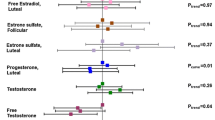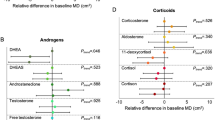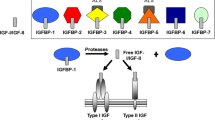Abstract
Background
Mammographic density represents epithelial and stromal proliferation, while insulin-like growth factor (IGF)-1, insulin-like growth factor-binding protein-3, growth hormone (GH), and estrogen may influence cellular proliferation. However, whether these growth factors independently, or in combination with estrogen, influence mammographic density in premenopausal women remains unclear.
Materials and methods
Growth factors were assessed in 202 ovulating premenopausal women participating in the Energy Balance and Breast Cancer Aspects-I study. Estrogen was assessed in serum, and daily in saliva, throughout a menstrual cycle. Computer-assisted mammographic density (Madena) was obtained from digitized mammograms (days 7–12 of the menstrual cycle). Associations between growth factors, estrogen, and mammographic density were studied in regression models.
Results
Women with a mean age of 30.7 years had a mean percent mammographic density of 29.8 %. Among women in the strata (above median split) of IGF-1 (>25 nmol/l) or GH (>0.80 mlU/l), we observed that an increase in salivary 17β-estradiol was associated with a higher odds for having higher percent mammographic density (>28.5 %). The odds ratios (ORs) per standard deviation increase in 17β-estradiol were 1.81 [95 % confidence interval (CI) 1.08–3.03] in the high IGF-1 stratum and 2.08 (95 % CI 1.10–3.94) in the high GH stratum. Furthermore, women in these strata of growth factors (above median) who had an overall average 17β-estradiol above median (>16.8 pmol/l) had higher ORs for having higher percent mammographic density (>28.5 %): IGF-1 4.13 (95 % CI 1.33–12.83) and GH 4.17 (95 % CI 1.41–12.28).
Conclusion
Growth factors, in combination with cycling estrogen, were associated with percent mammographic density, and may be of potential clinical relevance.

Similar content being viewed by others
References
Yaghjyan L, Colditz GA, Rosner B, Tamimi RM (2013) Mammographic breast density and subsequent risk of breast cancer in postmenopausal women according to the time since the mammogram. Cancer Epidemiol Biomark Prev 22(6):1110–1117. doi:10.1158/1055-9965.epi-13-0169
Hankinson SE, Willett WC, Colditz GA, Hunter DJ, Michaud DS, Deroo B, Rosner B, Speizer FE, Pollak M (1998) Circulating concentrations of insulin-like growth factor-I and risk of breast cancer. Lancet 351(9113):1393–1396. doi:10.1016/s0140-6736(97)10384-1
Diorio C, Pollak M, Byrne C, Masse B, Hebert-Croteau N, Yaffe M, Cote G, Berube S, Morin C, Brisson J (2005) Insulin-like growth factor-I, IGF-binding protein-3, and mammographic breast density. Cancer Epidemiol Biomark Prev 14(5):1065–1073. doi:10.1158/1055-9965.epi-04-0706
Pollak M (2012) The insulin and insulin-like growth factor receptor family in neoplasia: an update. Nat Rev Cancer 12(3):159–169. doi:10.1038/nrc3215
Memmott RM, Dennis PA (2009) Akt-dependent and -independent mechanisms of mTOR regulation in cancer. Cell Signal 21(5):656–664. doi:10.1016/j.cellsig.2009.01.004
Rice MS, Tworoger SS, Rosner BA, Pollak MN, Hankinson SE, Tamimi RM (2012) Insulin-like growth factor-1, insulin-like growth factor-binding protein-3, growth hormone, and mammographic density in the Nurses’ Health Studies. Breast Cancer Res Treat 136(3):805–812. doi:10.1007/s10549-012-2303-2
Izzo L, Meggiorini ML, Nofroni I, Pala A, De Felice C, Meloni P, Simari T, Izzo S, Pugliese F, Impara L, Merlini G, Di Cello P, Cipolla V, Forcione AR, Paliotta A, Domenici L, Bolognese A (2012) Insulin-like growth factor-I (IGF-1), IGF-binding protein-3 (IGFBP-3) and mammographic features. Il Giornale di chirurgia 33(5):153–162
Ursin G, Parisky YR, Pike MC, Spicer DV (2001) Mammographic density changes during the menstrual cycle. Cancer Epidemiol Biomark Prev 10(2):141–142
Hovhannisyan G, Chow L, Schlosser A, Yaffe MJ, Boyd NF, Martin LJ (2009) Differences in measured mammographic density in the menstrual cycle. Cancer Epidemiol Biomark Prev 18(7):1993–1999. doi:10.1158/1055-9965.epi-09-0074
Greendale GA, Reboussin BA, Slone S, Wasilauskas C, Pike MC, Ursin G (2003) Postmenopausal hormone therapy and change in mammographic density. J Natl Cancer Inst 95(1):30–37
McTiernan A, Martin CF, Peck JD, Aragaki AK, Chlebowski RT, Pisano ED, Wang CY, Brunner RL, Johnson KC, Manson JE, Lewis CE, Kotchen JM, Hulka BS (2005) Estrogen-plus-progestin use and mammographic density in postmenopausal women: women’s Health Initiative randomized trial. J Natl Cancer Inst 97(18):1366–1376. doi:10.1093/jnci/dji279
Boyd NF, Melnichouk O, Martin LJ, Hislop G, Chiarelli AM, Yaffe MJ, Minkin S (2011) Mammographic density, response to hormones, and breast cancer risk. J Clin Oncol 29(22):2985–2992. doi:10.1200/jco.2010.33.7964
Rossouw JE, Anderson GL, Prentice RL, LaCroix AZ, Kooperberg C, Stefanick ML, Jackson RD, Beresford SA, Howard BV, Johnson KC, Kotchen JM, Ockene J (2002) Risks and benefits of estrogen plus progestin in healthy postmenopausal women: principal results From the Women’s Health Initiative randomized controlled trial. JAMA, J Am Med Assoc 288(3):321–333
Schoemaker MJ, Folkerd EJ, Jones ME, Rae M, Allen S, Ashworth A, Dowsett M, Swerdlow AJ (2014) Combined effects of endogenous sex hormone levels and mammographic density on postmenopausal breast cancer risk: results from the Breakthrough Generations Study. Br J Cancer 110(7):1898–1907. doi:10.1038/bjc.2014.64
Key TJ, Appleby PN, Reeves GK, Roddam AW (2010) Insulin-like growth factor 1 (IGF1), IGF binding protein 3 (IGFBP3), and breast cancer risk: pooled individual data analysis of 17 prospective studies. Lancet Oncol 11(6):530–542. doi:10.1016/s1470-2045(10)70095-4
Hamelers IH, Steenbergh PH (2003) Interactions between estrogen and insulin-like growth factor signaling pathways in human breast tumor cells. Endocr Relat Cancer 10(2):331–345
Kaaks R, Johnson T, Tikk K, Sookthai D, Tjonneland A, Roswall N, Overvad K, Clavel-Chapelon F, Boutron-Ruault MC, Dossus L, Rinaldi S, Romieu I, Boeing H, Schutze M, Trichopoulou A, Lagiou P, Trichopoulos D, Palli D, Grioni S, Tumino R, Sacerdote C, Panico S, Buckland G, Arguelles M, Sanchez MJ, Amiano P, Chirlaque MD, Ardanaz E, Bueno-de-Mesquita HB, van Gils CH, Peeters PH, Andersson A, Sund M, Weiderpass E, Torhild Gram I, Lund E, Khaw KT, Wareham N, Key TJ, Travis RC, Merritt MA, Gunter MJ, Riboli E, Lukanova A (2013) Insulin-like growth factor I and risk of breast cancer by age and hormone receptor status-A prospective study within the EPIC cohort. Int J Cancer. doi:10.1002/ijc.28589
Felice DL, El-Shennawy L, Zhao S, Lantvit DL, Shen Q, Unterman TG, Swanson SM, Frasor J (2013) Growth hormone potentiates 17beta-estradiol-dependent breast cancer cell proliferation independently of IGF-I receptor signaling. Endocrinology 154(9):3219–3227. doi:10.1210/en.2012-2208
Furberg AS, Jasienska G, Bjurstam N, Torjesen PA, Emaus A, Lipson SF, Ellison PT, Thune I (2005) Metabolic and hormonal profiles: HDL cholesterol as a plausible biomarker of breast cancer risk. The Norwegian EBBA Study. Cancer epidemiology, biomarkers & prevention. Oncology 14(1):33–40
Emaus A, Espetvedt S, Veierod MB, Ballard-Barbash R, Furberg AS, Ellison PT, Jasienska G, Hjartaker A, Thune I (2008) 17-beta-estradiol in relation to age at menarche and adult obesity in premenopausal women. Hum Reprod 23(4):919–927. doi:10.1093/humrep/dem432
Emaus A, Veierod MB, Furberg AS, Espetvedt S, Friedenreich C, Ellison PT, Jasienska G, Andersen LB, Thune I (2008) Physical activity, heart rate, metabolic profile, and estradiol in premenopausal women. Med Sci Sports Exerc 40(6):1022–1030. doi:10.1249/MSS.0b013e318167411f
Finstad SE, Emaus A, Tretli S, Jasienska G, Ellison PT, Furberg AS, Wist EA, Thune I (2009) Adult height, insulin, and 17beta-estradiol in young women. Cancer Epidemiol Biomark Prev 18(5):1477–1483. doi:10.1158/1055-9965.epi-08-0972
Bellem A, Meiyappan S, Romans S, Einstein G (2011) Measuring estrogens and progestagens in humans: an overview of methods. Gend Med 8(5):283–299. doi:10.1016/j.genm.2011.07.001
Ellison PT (1994) Advances in human reproductive ecology. Annu Rev Anthropol 23:255–275. doi:10.1146/annurev.an.23.100194.001351
Lipson SF, Ellison PT (1989) Development of protocols for the application of salivary steroid analysis to field conditions. Am J Hum Biol 1(3):249–255. doi:10.1002/ajhb.1310010304
Ellison PT, Lipson SF (1999) Salivary estradiol—a viable alternative? Fertil Steril 72(5):951–952
Bjurstam N, Bjorneld L, Warwick J, Sala E, Duffy SW, Nystrom L, Walker N, Cahlin E, Eriksson O, Hafstrom LO, Lingaas H, Mattsson J, Persson S, Rudenstam CM, Salander H, Save-Soderbergh J, Wahlin T (2003) The Gothenburg breast screening trial. Cancer 97(10):2387–2396. doi:10.1002/cncr.11361
Ursin G, Astrahan MA, Salane M, Parisky YR, Pearce JG, Daniels JR, Pike MC, Spicer DV (1998) The detection of changes in mammographic densities. Cancer Epidemiol Biomark Prev 7(1):43–47
Ursin G, Ma H, Wu AH, Bernstein L, Salane M, Parisky YR, Astrahan M, Siozon CC, Pike MC (2003) Mammographic density and breast cancer in three ethnic groups. Cancer Epidemiol Biomark Prev 12(4):332–338
Matthews JN, Altman DG, Campbell MJ, Royston P (1990) Analysis of serial measurements in medical research. BMJ 300(6719):230–235
Bertrand KA, Eliassen AH, Hankinson SE, Gierach GL, Xu X, Rosner B, Ziegler RG, Tamimi RM (2012) Urinary estrogens and estrogen metabolites and mammographic density in premenopausal women. Breast Cancer Res Treat 136(1):277–287. doi:10.1007/s10549-012-2240-0
Maskarinec G, Heak S, Morimoto Y, Custer L, Franke AA (2012) The relation of urinary estrogen metabolites with mammographic densities in premenopausal women. Cancer Epidemiol 36(5):e310–e316. doi:10.1016/j.canep.2012.03.014
Walker K, Fletcher O, Johnson N, Coupland B, McCormack VA, Folkerd E, Gibson L, Hillier SG, Holly JM, Moss S, Dowsett M, Peto J, dos Santos Silva I (2009) Premenopausal mammographic density in relation to cyclic variations in endogenous sex hormone levels, prolactin, and insulin-like growth factors. Cancer Res 69(16):6490–6499. doi:10.1158/0008-5472.can-09-0280
Maskarinec G, Takata Y, Chen Z, Gram IT, Nagata C, Pagano I, Hayashi K, Arendell L, Skeie G, Rinaldi S, Kaaks R (2007) IGF-I and mammographic density in four geographic locations: a pooled analysis. Int J Cancer 121(8):1786–1792. doi:10.1002/ijc.22834
dos Santos Silva I, Johnson N, De Stavola B, Torres-Mejia G, Fletcher O, Allen DS, Allen NE, Key TJ, Fentiman IS, Holly JM, Peto J (2006) The insulin-like growth factor system and mammographic features in premenopausal and postmenopausal women. Cancer Epidemiol Biomark Prev 15(3):449–455. doi:10.1158/1055-9965.epi-05-0555
Rinaldi S, Biessy C, Hernandez M, Lesueur F, dos-Santos-Silva I, Rice MS, Lajous M, Lopez-Ridaura R, Torres-Mejia G, Romieu I (2014) Circulating concentrations of insulin-like growth factor-I, insulin-like growth factor-binding protein-3, genetic polymorphisms and mammographic density in premenopausal Mexican women: results from the ESMaestras cohort. Int J Cancer 134(6):1436–1444. doi:10.1002/ijc.28469
van Gils CH, Hendriks JH, Otten JD, Holland R, Verbeek AL (2000) Parity and mammographic breast density in relation to breast cancer risk: indication of interaction. Eur J Cancer Prev 9(2):105–111
Boyd NF, Martin LJ, Yaffe MJ, Minkin S (2011) Mammographic density and breast cancer risk: current understanding and future prospects. Breast Cancer Res 13(6):223. doi:10.1186/bcr2942
Martin LJ, Boyd NF (2008) Mammographic density. Potential mechanisms of breast cancer risk associated with mammographic density: hypotheses based on epidemiological evidence. Breast Cancer Res 10(1):201. doi:10.1186/bcr1831
Lokate M, Peeters PH, Peelen LM, Haars G, Veldhuis WB, van Gils CH (2011) Mammographic density and breast cancer risk: the role of the fat surrounding the fibroglandular tissue. Breast Cancer Res 13(5):R103. doi:10.1186/bcr3044
Yu Z, Gao W, Jiang E, Lu F, Zhang L, Shi Z, Wang X, Chen L, Lv T (2013) Interaction between IGF-IR and ER induced by E2 and IGF-I. PLoS ONE 8(5):e62642. doi:10.1371/journal.pone.0062642
Werner H (2012) Tumor suppressors govern insulin-like growth factor signaling pathways: implications in metabolism and cancer. Oncogene 31(22):2703–2714. doi:10.1038/onc.2011.447
Boyd NF, Stone J, Martin LJ, Jong R, Fishell E, Yaffe M, Hammond G, Minkin S (2002) The association of breast mitogens with mammographic densities. Br J Cancer 87(8):876–882. doi:10.1038/sj.bjc.6600537
Meggiorini ML, Cipolla V, Borgoni G, Nofroni I, Pala A, de Felice C (2012) Possible effects of insulin-like growth factor-I, IGF-binding protein-3 and IGF-1/IGFBP-3 molar ratio on mammographic density: a cross-sectional study. Eur J Gynaecol Oncol 33(1):74–78
McCormack VA, Dowsett M, Folkerd E, Johnson N, Palles C, Coupland B, Holly JM, Vinnicombe SJ, Perry NM, dos Santos Silva I (2009) Sex steroids, growth factors and mammographic density: a cross-sectional study of UK postmenopausal Caucasian and Afro-Caribbean women. Breast Cancer Res 11(3):R38. doi:10.1186/bcr2325
Borugian MJ, Spinelli JJ, Gordon PB, Abanto Z, Brooks-Wilson A, Pollak MN, Warren LJ, Hislop TG, Gallagher RP (2014) Fasting insulin and endogenous hormones in relation to premenopausal breast density (Canada). Cancer Causes Control 25(3):385–394. doi:10.1007/s10552-014-0339-9
Harrela M, Koistinen H, Kaprio J, Lehtovirta M, Tuomilehto J, Eriksson J, Toivanen L, Koskenvuo M, Leinonen P, Koistinen R, Seppala M (1996) Genetic and environmental components of interindividual variation in circulating levels of IGF-I, IGF-II, IGFBP-1, and IGFBP-3. J Clin Investig 98(11):2612–2615. doi:10.1172/jci119081
Ruan W, Kleinberg DL (1999) Insulin-like growth factor I is essential for terminal end bud formation and ductal morphogenesis during mammary development. Endocrinology 140(11):5075–5081. doi:10.1210/endo.140.11.7095
Kleinberg DL, Barcellos-Hoff MH (2011) The pivotal role of insulin-like growth factor I in normal mammary development. Endocrinology and metabolism clinics of North America 40(3):461–471, vii. doi:10.1016/j.ecl.2011.06.001
Kleinberg DL, Ruan W (2008) IGF-I, GH, and sex steroid effects in normal mammary gland development. J Mammary Gland Biol Neoplasia 13(4):353–360. doi:10.1007/s10911-008-9103-7
Saftlas AF, Hoover RN, Brinton LA, Szklo M, Olson DR, Salane M, Wolfe JN (1991) Mammographic densities and risk of breast cancer. Cancer 67(11):2833–2838
Diorio C, Brisson J, Berube S, Pollak M (2008) Intact and total insulin-like growth factor-binding protein-3 (IGFBP-3) levels in relation to breast cancer risk factors: a cross-sectional study. Breast Cancer Res 10(3):R42. doi:10.1186/bcr2093
Borofsky ND, Vogelman JH, Krajcik RA, Orentreich N (2002) Utility of insulin-like growth factor-1 as a biomarker in epidemiologic studies. Clin Chem 48(12):2248–2251
Gann PH, Giovanazzi S, Van Horn L, Branning A, Chatterton RT Jr (2001) Saliva as a medium for investigating intra- and interindividual differences in sex hormone levels in premenopausal women. Cancer Epidemiol Biomark Prev 10(1):59–64
Morrow M, Chatterton RT Jr, Rademaker AW, Hou N, Jordan VC, Hendrick RE, Khan SA (2010) A prospective study of variability in mammographic density during the menstrual cycle. Breast Cancer Res Treat 121(3):565–574. doi:10.1007/s10549-009-0496-9
Boyd NF, Martin LJ, Sun L, Guo H, Chiarelli A, Hislop G, Yaffe M, Minkin S (2006) Body size, mammographic density, and breast cancer risk. Cancer Epidemiol Biomark Prev 15(11):2086–2092. doi:10.1158/1055-9965.epi-06-0345
Byrne C, Schairer C, Wolfe J, Parekh N, Salane M, Brinton LA, Hoover R, Haile R (1995) Mammographic features and breast cancer risk: effects with time, age, and menopause status. J Natl Cancer Inst 87(21):1622–1629
Acknowledgments
We acknowledge each woman that participated in the EBBA-I study and give special thanks to Gunn Kristin Knudsen, Heidi Jakobsen, Anna-Kirsti Kvitnes, and Sissel Andersen for their professional assistance. We would also like to thank the Clinical Research Department, University Hospital of North Norway, Tromsø, for their skilled and always professional setting. This work was supported by the Norwegian Research Council (213997/H10), Foundation for the Norwegian Health and Rehabilitation Organization (59010-2000, 59010-2001, 59010-2002), and Norwegian Cancer Society (05087, TP 49,258).
Conflict of interest
None.
Author information
Authors and Affiliations
Corresponding author
Electronic supplementary material
Below is the link to the electronic supplementary material.
Rights and permissions
About this article
Cite this article
Frydenberg, H., Flote, V.G., Iversen, A. et al. Insulin-like growth factor-1, growth hormone, and daily cycling estrogen are associated with mammographic density in premenopausal women. Cancer Causes Control 25, 891–903 (2014). https://doi.org/10.1007/s10552-014-0389-z
Received:
Accepted:
Published:
Issue Date:
DOI: https://doi.org/10.1007/s10552-014-0389-z




